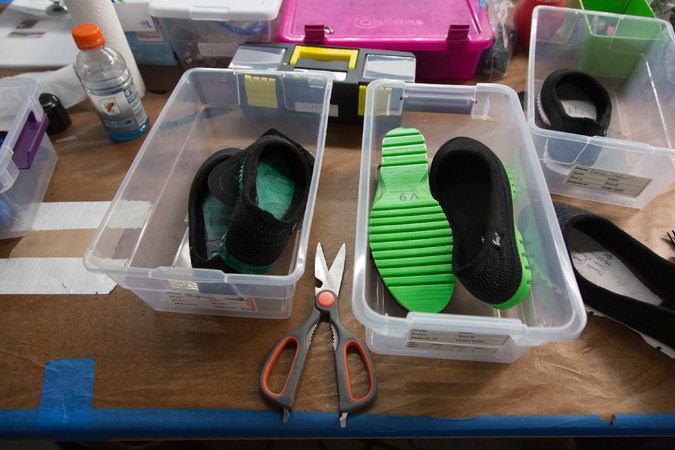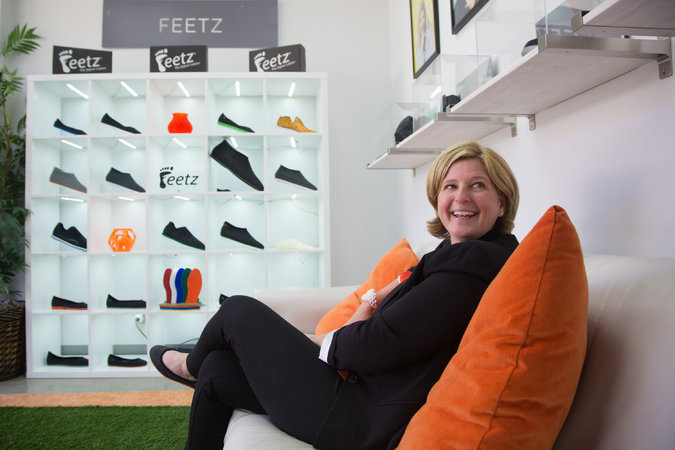Ordering is done online, where customers can download an app, take smartphone snapshots of their feet and create a 3-D model. Shoes, which cost $199, are made of recycled materials and are thickly padded for comfort.
Advertisement
Continue reading the main story
With the rise of new technologies like smartphones and 3-D printers, fashion start-ups like Feetz are changing the ways goods are ordered, made and sold.
Like Ms. Beard, several founders of these companies don’t have fashion backgrounds. Instead, they consider technology the answer to off-the rack, mass-produced goods, which are increasingly shunned by millennials. Consumers with hard-to-find sizes — like petite, or big and tall — will find shopping simpler.
Traditionally, manufacturing is the most expensive part of the retail supply chain. Creating goods in small batches is difficult and costly. Most are manufactured overseas, and shipping goods to the United States adds time and cost to the process. So even “fast fashion” can take about six weeks to hit store shelves.
The beauty of instant, customized fashion, experts say, is that goods can be made at a lower cost and more quickly — yet in a personalized style.
Although disruption is a hot idea in the tech world, not everyone is convinced that this type of innovation will revolutionize fashion. James Dion, a retail consultant in Chicago, said he viewed customizable fashion as a “passing fad” with limited appeal.
And the industry has already had one of its first failures: Tinker Tailor, which made custom luxury women’s apparel, closed last year after funding dried up.

These are still early days for 3-D printing, said Uli Becker, the former chief executive of Reebok and an investor in Feetz. The offerings are not very diversified, and they are limited to basic goods. And fabric cannot yet be printed.
But he sees great potential for 3-D printing. “You can start producing in America, for America,” he said. “Production facilities can be in the same place where you sell products, which creates jobs.”
Advertisement
Continue reading the main story
Also, the technology improves every month, Mr. Becker added. “This is the equivalent of the 1980s cellphone in a briefcase that puts a brick on your ear,” he said. “In the future, we’ll go into showrooms, select what we want and then order online or print out the product ourselves,” he said.
Custom shoemakers like Feetz will also make in-store shoe fittings obsolete, experts say. “In 10 years you won’t physically try on a pair of shoes,” Ms. Beard said.
The promise is making Silicon Valley take notice.
“We’ve been looking for companies that can use advanced technology,” said Vijit Sabnis, a venture partner at Khosla Ventures and an investor in Feetz. “And geeks and nerds are developing it. Feetz, for example, can change our experience in buying products.”
Retail goods will eventually be made by robots and 3-D printers, he said. And they will be made in hubs rather than big plants.
“We’ll get rid of shipping costs and rethink the supply chain,” he said. “It’s really cool.”
Khosla Ventures has also invested in fashion start-ups that use technology other than 3-D printing. One is Shoes of Prey, a website that allows shoppers to choose colors and styles of women’s shoes, in most cases, for less than $200. Another investment, MTailor, makes custom men’s shirts and suits by taking measurements on a smartphone. Shirts start at $69.
Even the humble T-shirt is being reinvented. Teespring, founded in 2011, shipped more than 20 million custom T-shirts last year. It allows anyone to design custom T-shirts with messages related to topics such as coffee, yoga and football and then sell them to customers.
“We’re a technology company that creates T-shirts,” said Walker Williams, 27, chief executive of Teespring, who started the company with Evan Stites-Clayton, a friend from Brown University. “The future of fashion is in smaller brands that have relationships with customers.”
Eventually, they plan to offer other custom clothing. Venture capitalists including Andreessen Horowitz, Khosla Ventures and Y Combinator have backed them to the tune of $56 million.

Teespring built its own manufacturing systems in a factory in northern Kentucky that once made helicopters. Of its 400 employees, 40 are on the engineering team, building patented technology for rapidly printing small batches of T-shirts. Profit margins are slim, Mr. Walker acknowledges, but they are rising.
Advertisement
Continue reading the main story
“Anyone can bring a creative idea to life without having to be a retail expert,” said Lars Dalgaard, general partner at Andreessen Horowitz. So consumers can now express themselves in a way “that was never possible before,” he added.
One promising area is custom women’s fashion. Shelly Madick and Aubrie Pagano, who met as students at Harvard, started Bow Drape.
Last year, the company opened a pop-up customization store in a Nordstrom location. Customers could design their own products on an iPad and pick them up the same day.
“It was a huge success,” said Ms. Pagano, Bow Drape’s chief executive, “and this year we’ll be doing it in 18 Nordstrom’s stores and with other retailers.”
After a successful Kickstarter campaign, the company has so far raised $2.6 million from investors like VTF Capital, started by Zappos’s chief, Tony Hsieh. Revenues last year were $1.2 million, and the company will be profitable by 2017, Ms. Pagano said.
As with any young industry, there have been stumbles. Bow Drape was using 3-D printers to make $100 belt buckles in stainless steel but abandoned that effort because of low demand.
“Online, our customers wouldn’t pay that amount,” she said. So right now, the company is not doing any 3-D printing. Instead, customization is done at the factory where the clothes are made, with a heat press.
Advertisement
Continue reading the main story
Technology is also helping start-ups hone their offerings with data analytics and algorithms. Stantt, a start-up based in New York, offers men’s shirts in 75 sizes based on just three measurements, guided by an algorithm.
The founders, who are former Johnson Johnson brand managers, have already raised $2.1 million from angel investors.
Shirts are made in one day in Central America. But because there is no intermediary and no leftover inventory, Stantt can sell its shirts for less than other custom shirt companies. Dress shirts, for example, sell for as little as $98 each.
“We’re not a fashion brand,” said Stantt’s chief executive and co-founder, Matt Hornbuckle, 31. “We’re creating something better, a perfect closet.”
Continue reading the main story
Article source: http://www.nytimes.com/2016/09/15/business/smallbusiness/your-next-pair-of-shoes-could-come-from-a-3-d-printer.html?partner=rss&emc=rss









